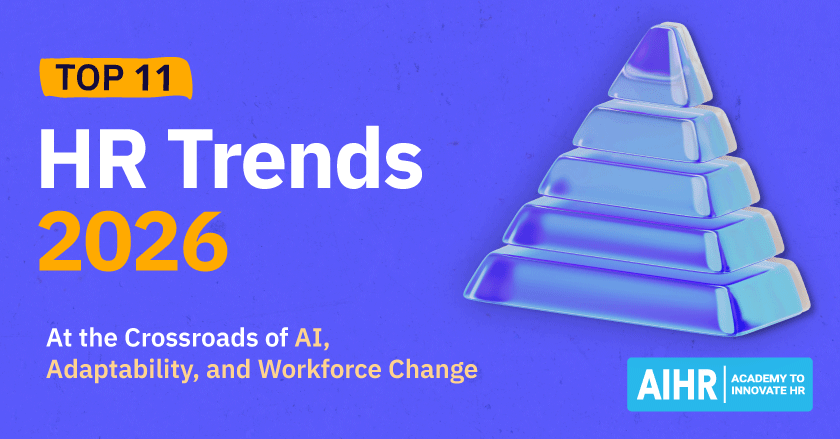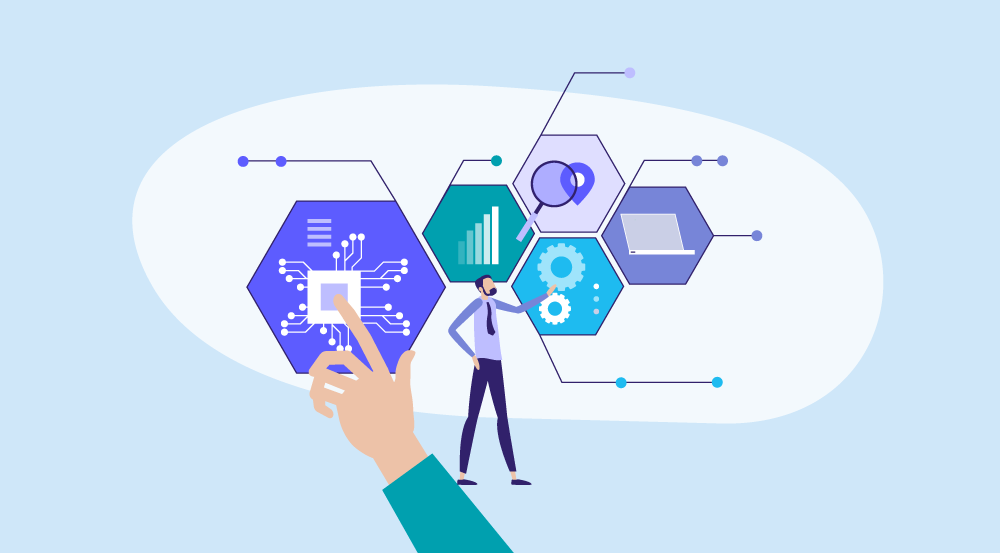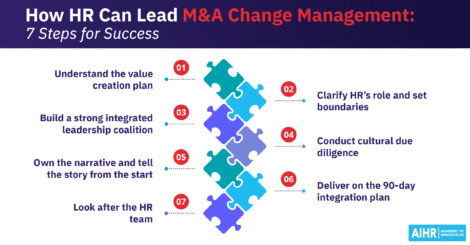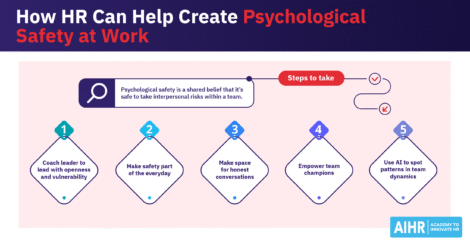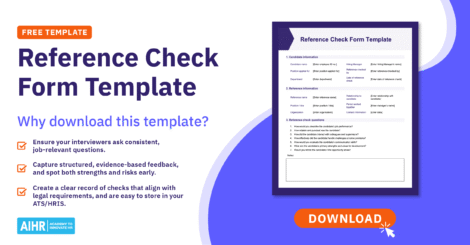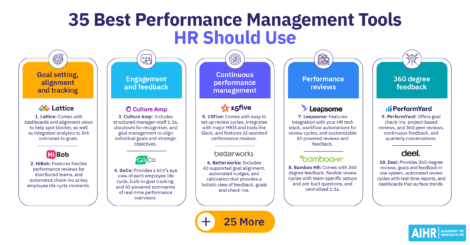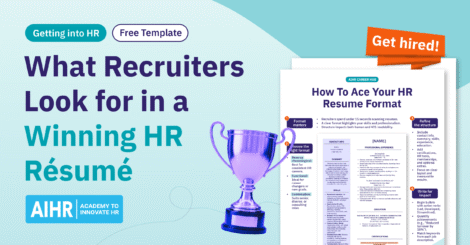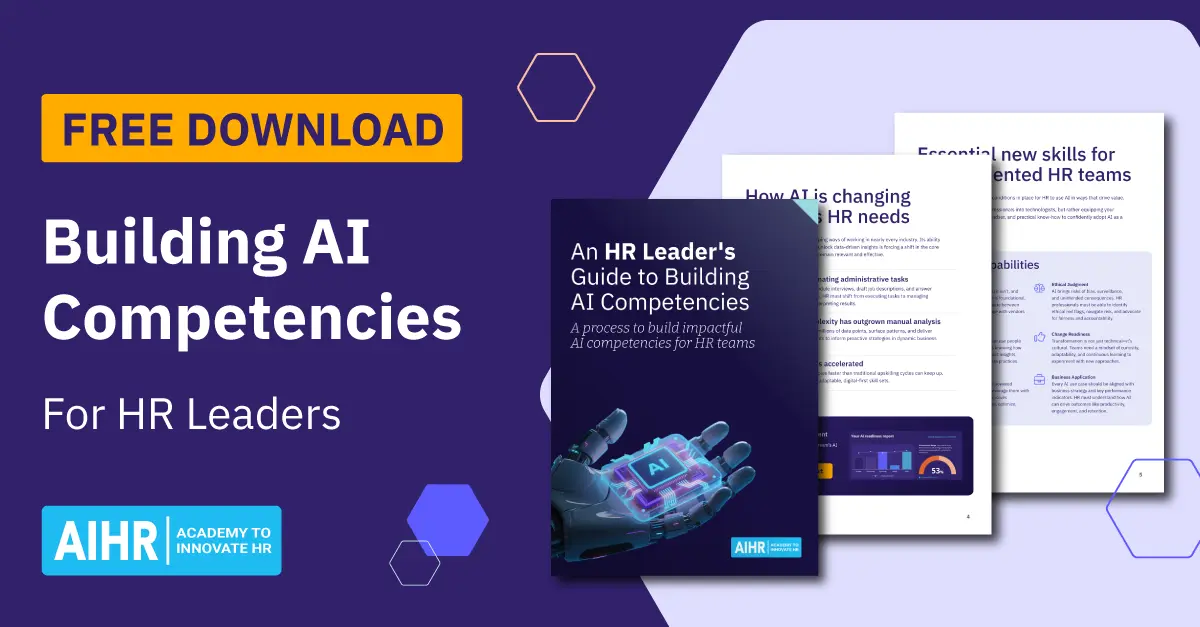The AI race is accelerating. Organizations across industries are urgently exploring how AI can boost productivity, expand capacity, and unlock new sources of value. As AIHR’s recent HR Priorities report shows, HR is uniquely positioned to co-lead this transformation, ensuring that AI adoption is not just fast, but systemic and sustainable.
Yet significant barriers to adoption persist. Insights from our collaboration with Lightcast reveal a critical disconnect: the challenge lies less in employee willingness and more in leadership’s approach to AI adoption. While most leaders support AI in principle, they haven’t translated that support into structured, scalable action.
Early pilots often remain isolated, disconnected from real HR workflows and broader business impact. Too many organizations have fallen into the trap of fragmented pilots and unstructured experimentation, neglecting the integrated approach required to turn promise into performance.
This article examines what true AI readiness means and how HR can play a decisive role in guiding organizations to mature their AI practices, anchoring them in strategy, enabling them through technology, and amplifying them through people.
Contents
Why is AI adoption not only about technology?
What is AI readiness?
AI readiness pillars for the business and HR
How AI readiness enables maturity and value creation
How HR can drive AI readiness and maturity
Why is AI adoption not only about technology?
Over the past two years, it’s become clear that successful AI adoption depends less on technology, tools, or data and more on how work itself is designed. For many organizations, the real challenge is reshaping workflows and cultivating an open and ready culture to integrate AI meaningfully and at scale. This involves redesigning roles, rethinking processes, and supporting employees through change, all of which fall directly under HR’s scope.
This becomes even more important with the rise of agentic AI, where value isn’t just added in support tasks, but generated directly through core workflows, decision-making, and day-to-day operations.
Yet most organizations are stuck at the starting line. AI adoption remains confined to the individual level: employees are handed tools, guardrails are loosened, and they are encouraged to experiment. While this can drive impressive personal productivity gains, it rarely translates into systemic impact.
Few organizations have managed to move beyond individual tinkering toward embedding AI into shared practices, integrated workflows, or enterprise-wide operating models. The real competitive advantage will not come from the number of employees who use AI but from how deeply AI is woven into the organization’s core ways of working.
I think this is a really interesting implementation balance to strike, because you have to look at it almost like a matrix of two different factors. One is, is it a top-down initiative or is it bottom-up? And the other is, is it a very high control or a very low control environment?

Because if you have a top-down directive and an extremely high control environment, when was the last time your boss knew what tools you needed to do your job? So the chances are the three approved tools might not really be hitting the mark for what you needed to get done. But at the same time, if it’s extremely high control, most people are just going to go onto their phone, go on ChatGPT anyway, and now you have shadow AI, which is a huge issue.

Moving from individual experimentation to enterprise-wide transformation requires intention. It’s about building the right capabilities, implementing smart guardrails, and shaping a culture that can actually absorb and amplify AI. HR’s role in this is foundational, from activating new skill sets and creating the cultural conditions for AI to thrive to evolving organizational structures. Without this, organizations risk mistaking a burst of activity for real progress.
What is AI readiness?
AI readiness is the ability to successfully adopt AI in a business-focused and sustainable manner. In our work with businesses, we’ve determined that they need to have five readiness pillars in place to drive sustainable AI progress:
- Strategy
- Governance
- Technology
- People
- Skills
Importantly, AI readiness reflects how effectively the different pillars are integrated and work together rather than how they perform individually.
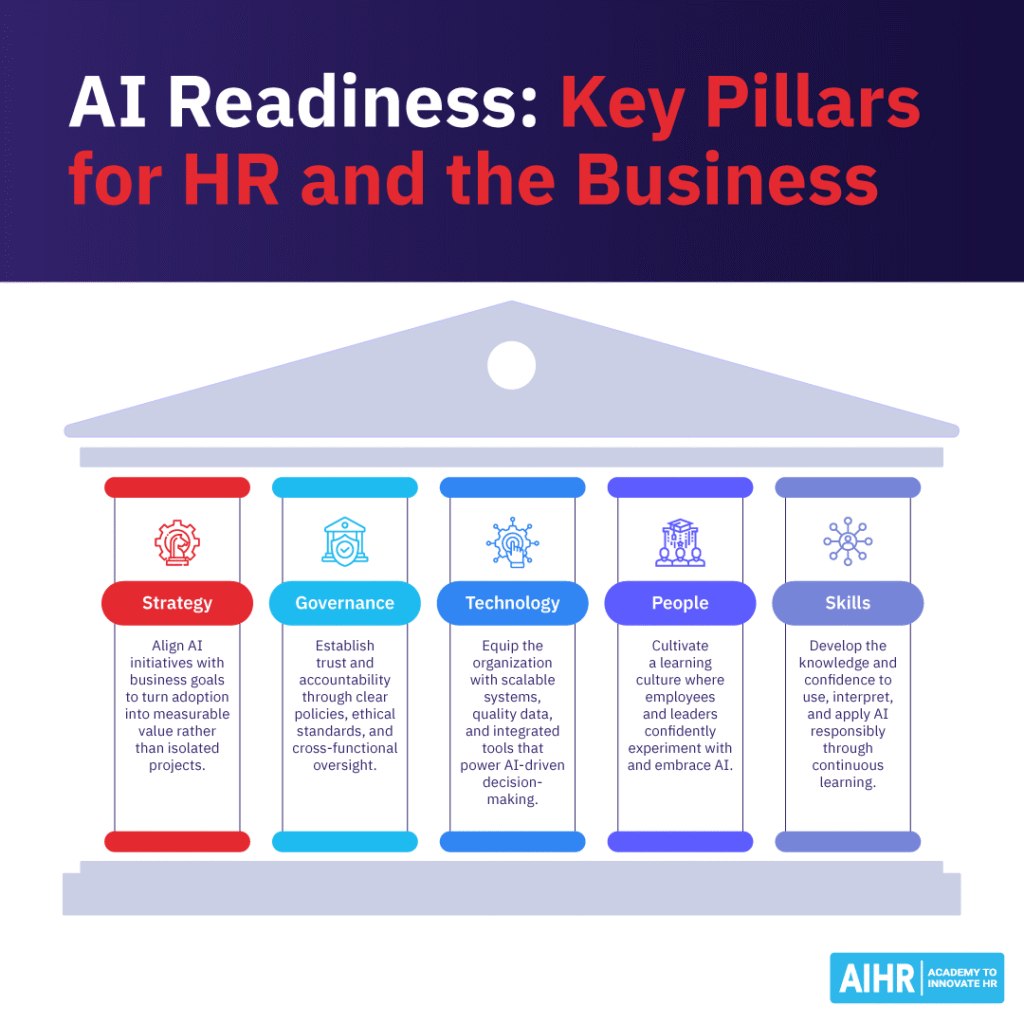
AI readiness pillars for the business and HR
Let’s take a look at each pillar and how HR leaders can start building them up:
Strategy
AI readiness starts with strategy. For organizations, this means moving away from treating AI as a side project or disconnected experiment and instead viewing it as a key driver of how the business creates value.
Aligning AI initiatives with strategic goals sets the direction and defines the “why” behind adoption, clarifying what success looks like and where AI can deliver its greatest impact.
HR plays a crucial role in enabling this process. By bringing business and functional leaders together, HR can help define AI’s purpose, establish clear success metrics, and identify use cases that directly support organizational priorities. When HR facilitates these conversations, AI becomes embedded in the organization’s operations, enabling more intelligent decision-making and measurable business outcomes rather than isolated technological wins.
Readiness checklist
- A defined promise of value and the purpose of AI for the business
- Defined success criteria and metrics for AI initiatives
- Identified use cases aligned to overall strategic objectives.
Building organizational AI readiness and maturity starts with equipping your HR team. As AI adoption expands, your people need the fluency to evaluate tools, apply them responsibly, and lead transformation efforts with confidence.
AIHR’s AI for HR Boot Camp enables your team to:
✅ Build foundational AI fluency to support informed decision-making
✅ Gain hands-on experience applying generative AI tools in HR contexts
✅ Analyze ethical, legal, and operational risks in AI adoption
✅ Identify high-impact, practical use cases aligned with business goals.
🎯 Achieve AI maturity with practical skills your HR team can apply today.
Governance
Instead of becoming a bureaucratic hurdle, governance provides the structure that ensures AI initiatives are built on trust, aligned with compliance, and resilient against risk. It clarifies what’s allowed, how decisions are made, and where accountability lies, removing friction and uncertainty from the process.
Governance anchors the responsible use of AI in fairness, transparency, and accountability. This includes identifying potential risks, setting clear policies, and maintaining oversight over how AI decisions are made and monitored.
HR contributes significantly here, especially as the steward of employee data and workplace ethics. By partnering with legal, compliance, and IT, HR can help create governance frameworks that uphold integrity and protect stakeholders. HR can also lead training and awareness programs to educate teams on what ethical AI use looks like in daily operations and build a culture where innovation and responsibility advance hand in hand.
Readiness checklist
- Identified risks related to AI use across the organization
- Clear policies and guidelines on how AI should be used
- Processes to monitor compliance and support ethical decision-making for AI
- Cross-functional CoE team in place, owning AI adoption
- A list of approved AI tools and access for employees
HR can encompass so many important roles within an organization. For example, in learning and development, with things like the EU AI Act, it’s HR’s job to make sure everyone is feeling at least some level of literacy. When we look at governance, HR is also closely tied to legal in many instances. So, how do we put safeguards in place while maintaining that human-centric AI element of it

Technology
Your business can only achieve your ambitious AI goals when the underlying systems are ready to support them. That means having reliable data, a robust infrastructure, and tools that integrate seamlessly across workflows.
Clean, connected, and accessible data is the foundation for AI impact. With scalable systems and well-integrated tools, AI solutions are not short-lived experiments but evolve with the business and bring continuous value.
HR can partner with IT to identify gaps in data quality, integration, accessibility, and system scalability. When HR is part of these conversations and decisions, organizations can make technology choices that truly support people and process goals and result in real organizational advantage.
Readiness checklist
- Reliable, structured business data
- Tools and platforms that support AI use across the organization
- Systems that are scalable and easy to integrate for AI solutions
- A technology roadmap for future AI adoption
People
Even the best tools and strategies fall flat if employees aren’t open to experimenting, learning, and adapting. Change accelerates when people see AI as something that helps them rather than is pushed upon them. Visible leadership support and everyday use of AI tools are often the strongest signals that an organization is truly ready to embrace this shift.
Culture plays a decisive role here. A culture that rewards curiosity, values learning, and celebrates experimentation is far more likely to turn AI ambition into reality. This is where HR becomes a powerful enabler. By creating psychologically safe spaces to learn, spotlighting early wins, and empowering AI champions to lead by example, HR helps build momentum and confidence across teams.
Through stories, collaboration, and real use cases that show how AI simplifies work and sharpens decisions, skepticism turns into engagement. When leaders model this behavior and teams feel trusted to explore, AI stops being a side project and becomes part of the organizational DNA. And when that happens, innovation doesn’t just spread from the top down; it grows through collective ownership.
Readiness checklist
- Clear understanding of AI’s value for the business
- Visible support from business leaders
- Practical examples of AI being used in everyday business operations
- Sharing of success stories
- Encouraging and rewarding experimentation.
Skills
Finally, AI readiness depends on skills—the ability of people to understand, interpret, and apply AI effectively and ethically. Beyond technical know-how, employees need confidence in using AI insights for decision-making, awareness of bias and fairness, and the capacity to adapt as tools evolve.
HR’s role is to make this learning accessible, continuous, and relevant to real work. This happens through integrating AI capability-building into learning programs, mentoring, and everyday tasks. Embedding ethical considerations into every learning moment makes the organization’s progress in AI maturity responsible and sustainable.
This way, HR helps create a workforce that doesn’t just use AI but understands its implications, ethically, practically, and strategically. As a result, the business becomes truly AI-ready, equipped to thrive in a future where technology and human potential advance together.
Readiness checklist
- Core skills and confidence to use AI across the workforce
- Opportunities to apply AI tools in daily work
- Ongoing learning and skill development for AI capabilities
- AI fluency is incorporated into job design and competency frameworks.
We discussed the different aspects of AI maturity with Eryn Peters, co-creator of AI Maturity Index. Watch the full interview below:
How AI readiness enables maturity and value creation
Readiness is only the starting point of AI adoption. The real value emerges when organizations advance and mature their AI capabilities in an integrated manner across these five pillars. However, maturity should not be viewed as a universal end goal or a race to the top. Not every organization needs to operate at the highest level of AI maturity to achieve meaningful impact.
A more effective approach is to pursue best-fit maturity, a level of capability that aligns with the organization’s strategy, operating model, and ambition. Instead of striving for the highest maturity possible, organizations should first define the value they want AI to deliver, determine the maturity level required to realize that value, and set up the five readiness pillars in a way that supports and enables the desired maturity and intended value.
A saying that’s become popular is “AI won’t steal your job, but someone who can use it better than you will.” I don’t think that’s a helpful narrative because more usage isn’t always better, and not every company, team, or role is built the same when it comes to AI.

It’s not fair to compare someone in HR to a software developer who’s been building AI tools for 20 years, or someone in healthcare, where data use is heavily regulated, to someone in tech, where governance is often optional. Benchmarking matters because it helps people avoid feeling left behind and gives them the confidence to ask the right questions.

By pursuing best-fit maturity, organizations can prioritize investments where they matter most. AI adoption can then deliver sustained value rather than chase maturity benchmarks that may not serve their strategic objectives.
| Integrated AI readiness across the pillars required to deliver this value | ||||||
| Value intent | Best-Fit Maturity Level | Strategy | Governance | Technology | People | Skills |
| AI delivers ad-hoc value in an unstructured manner, where opportunities are spotted | 1. Emerging | AI is recognized as strategically relevant but not yet prioritized. | Awareness of ethical, legal, and risk issues exists but is informal. | Initial experiments and early assessments demonstrate feasibility. | Curiosity and early interest in AI begin to surface across teams. | Basic AI literacy and awareness established. |
| AI creates localized improvements and proof of value through targeted use cases. | 2. Developing | AI initiatives are linked to clear business needs and pain points. | Governance provides light structure for responsible experimentation. | Early solutions deliver localized, measurable improvements. | Pockets of champions drive adoption and learning. | Targeted, role-specific AI competencies developed. |
| AI delivers consistent, reliable value through structured and aligned adoption. | 3. Established | AI priorities are embedded within core business strategies. | Governance structures provide clarity, accountability, and ethical consistency. | Scalable data and infrastructure support reliable AI deployment. | Broad workforce engagement and trust in AI decisions are established. | AI fluency and baseline capability are widespread across the organization. |
| AI drives connected, enterprise-wide value through integration into daily work. | 4. Integrated | AI consistently informs and optimizes cross-functional decision-making. | Governance is integrated into operational workflows and performance systems. | Interoperable AI platforms enable enterprise-wide efficiency and scalability. | AI adoption is normalized across teams and embedded in daily collaboration. | Human-AI collaboration capabilities are part of everyday work practices. |
| AI enables continuous innovation and strategic advantage at enterprise scale.. | 5. Transformative | AI is a core enabler of business agility, innovation, and strategic differentiation. | Governance is adaptive and self-learning, balancing innovation and responsibility. | Enterprise-grade AI ecosystem drives innovation and continuous value creation. | AI is ingrained in culture, leadership mindset, and organizational identity. | Continuous skill evolution and adaptive learning are institutionalized. |
How HR can drive AI readiness and maturity
HR is uniquely positioned to connect strategy, people, and technology in a way that accelerates responsible adoption. By bringing leaders together to define AI’s purpose, align initiatives with business priorities, and measure impact, HR helps transform AI into a strategic enabler—not an isolated experiment. This clarity of direction is what turns curiosity about AI into meaningful progress.
As maturity grows, HR becomes the guardian of trust and ethics in AI use. Robust governance, built on clear policies, transparency, and shared accountability, ensures AI decisions are fair, explainable, and compliant. When employees trust the systems they use, adoption follows naturally, and AI shifts from a technical add-on to a strategic business partner.
To drive AI readiness and maturity, HR should:
- Start from within: The journey begins inside the HR function. Too often, HR looks outward—enabling others—without first building its own confidence, capability, and clarity on how AI will reshape its operating model. Before guiding the business, HR must reflect inward: assess data maturity, rethink workflows, and ensure technology and skills are fit for purpose. What’s more, HR teams that experiment with AI build credibility and empathy for employees’ learning curves, showing that progress comes through exploration and iteration. Practicing what we preach means experiencing firsthand how AI streamlines processes, improves insights, and elevates service delivery.
- Develop employee AI fluency: Build understanding and confidence across the workforce. When HR drives accessible, ongoing learning, employees are better equipped to use AI effectively and responsibly.
- Enable leadership role-modeling: Encourage leaders to define AI’s purpose, align initiatives with strategic priorities, and visibly use AI tools in their work. Leadership involvement sets the tone for adoption and trust.
- Foster experimentation: Create space for testing, learning, and innovation. Encourage teams to explore new tools, share lessons learned, and understand that mistakes are part of the learning process. Normalizing experimentation, including setbacks, helps build confidence, curiosity, and a culture where progress comes through trying, refining, and improving together.
Final words
The journey to AI maturity is not a destination but a continuous evolution. Organizations can strategically integrate AI by prioritizing a “best-fit maturity” approach that serves their unique goals rather than chasing universal benchmarks.
HR plays an essential role in this transformation, fostering a culture of trust, ethical governance, and continuous learning. By leading from within, HR can demonstrate the tangible benefits of AI, empowering individuals and shaping an organizational DNA where human and artificial intelligence collaborate to create lasting value.


